Chapter 6: Organizational Structure and Design
1/46
There's no tags or description
Looks like no tags are added yet.
Name | Mastery | Learn | Test | Matching | Spaced |
|---|
No study sessions yet.
47 Terms
Principles of Organizational Structure
-Organizational structure (2)
-Organizational design (1)
Organizational structure
the sum of ways an org. divides its labor into distinct tasks and then coordinates them.
Organizational design
The process of assessing the organization’s strategy and environmental demands and then determining the appropriate structure.
What do organizational charts depict?
They illustrate relationships among units and lines of authority among supervisors
Typically use labeled boxes and connecting lines
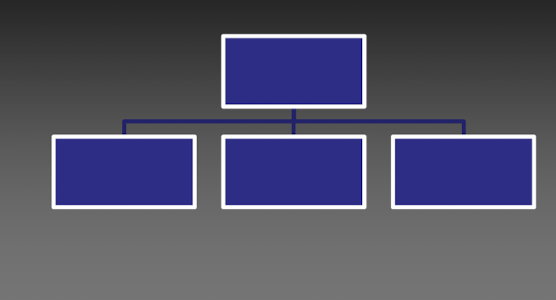
Structure vs. Org Chart
An organizational chart is NOT the same thing as its structure.
The chart depicts formal lines of authority and reporting relationships.
But in many organizations, informal relationships are key.
Example: The Obama White House
Differentiation
the extent to which tasks are divided into subtasks that are performed by individuals with specialized skills
the greater the complexity of the task, the more differentiation is required
Example: Boeing requires many engineers to design its aircraft; some design wings, others design doors.
Task Differentiation
Differentiation based on what employees do.
Cognitive differentiation
the extent to which people in different units of an organization think about different things — or about similar things — in different ways.
Integration
the extent to which various parts of an organization cooperate and interact with each other.
Boundary spanner
A person who coordinates activities across different units of the organization
Interdependence
the degree to which one unit or one person depends on another to accomplish a task.
driving force of nature
Different Types of Interdependence
Pooled
Sequential
Reciprocal
Pooled Interdependence
when various groups are largely independent in their functions but collectively contribute to the common output.
Sequential Interdependence
when the outputs of one group become the inputs of another group.
Reciprocal Interdependence
when two or more groups depend on one another for independence.
Which Type of Interdependence?:
The purchasing manager selects premium cucumbers to turn into kosher dills
The operations manager oversees the brining process.
The sales manager oversees sales to wholesalers and restaurants.
Together, they exhibit:
pooled
sequential
reciprocal
Sequential
Which type of Interdependence?:
•Picklemania grips the nation, creating huge demand for Wernicks kosher pickles.
The wholesale product mgr sells to the school cateteria.
The retail product mgr sells to pushcart vendors on campus.
Together they exhibit:
pooled
sequential
reciprocal
Pooled
Which type of Interdependence?:
The new product development manager relies on the marketing manager for info on consumer trends.
The marketing mgr relies on the new product development mgr for new products to test on consumers (e.g., pickle-flavored frappuccinos).
Together, they exhibit:
pooled
sequential
reciprocal
Reciprocal
Formalization
An organization’s official and defined systems for decision making, communication, and control; it is one way to balance differentiation and integration.
Ways to achieve formalization:
Designate line of authority
Stress unity of command
Limit a surpervisor’s span of control
Line of Authority
specifies who reports to whom.
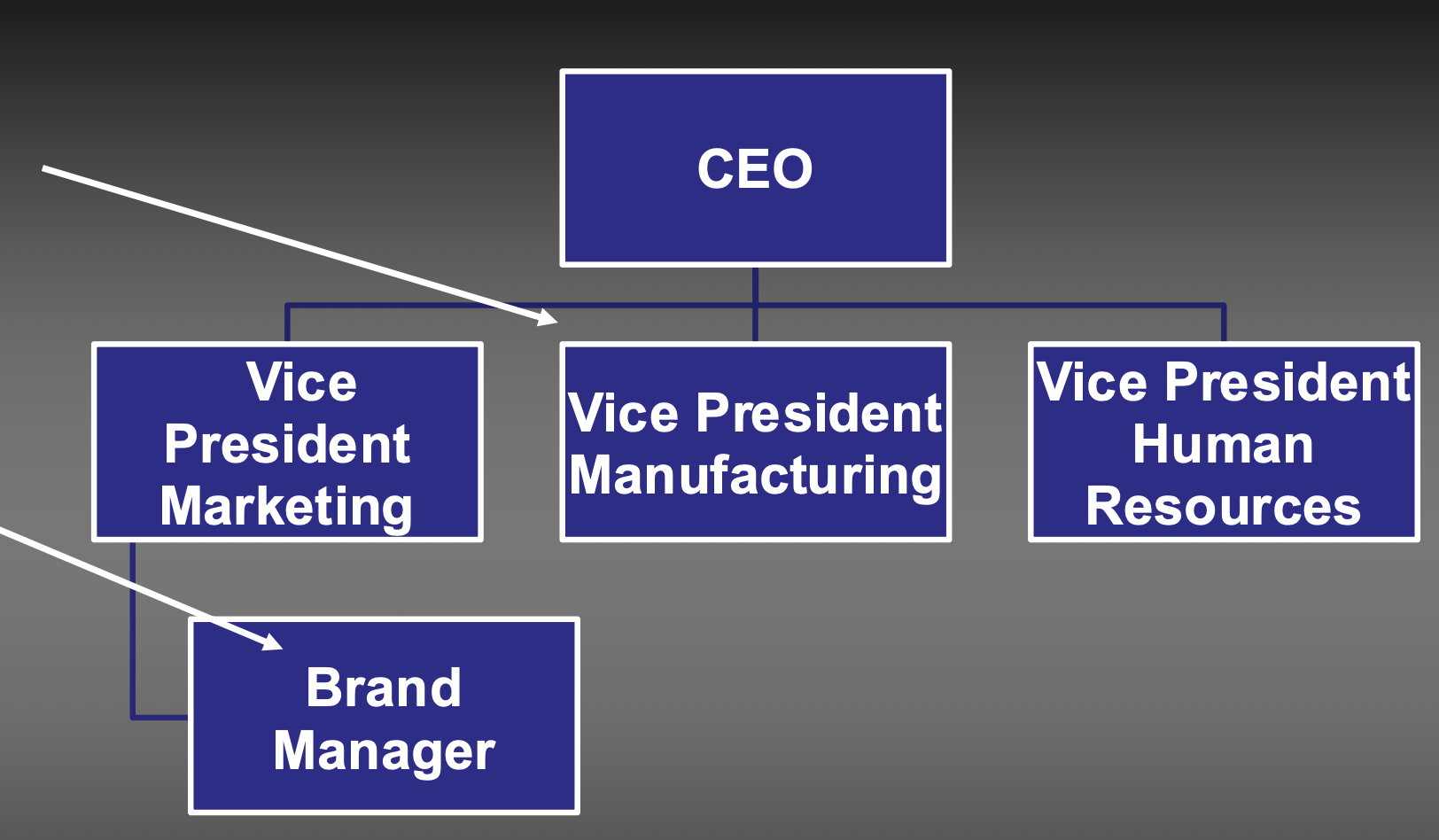
Unity of Command
An employee should have only one boss.
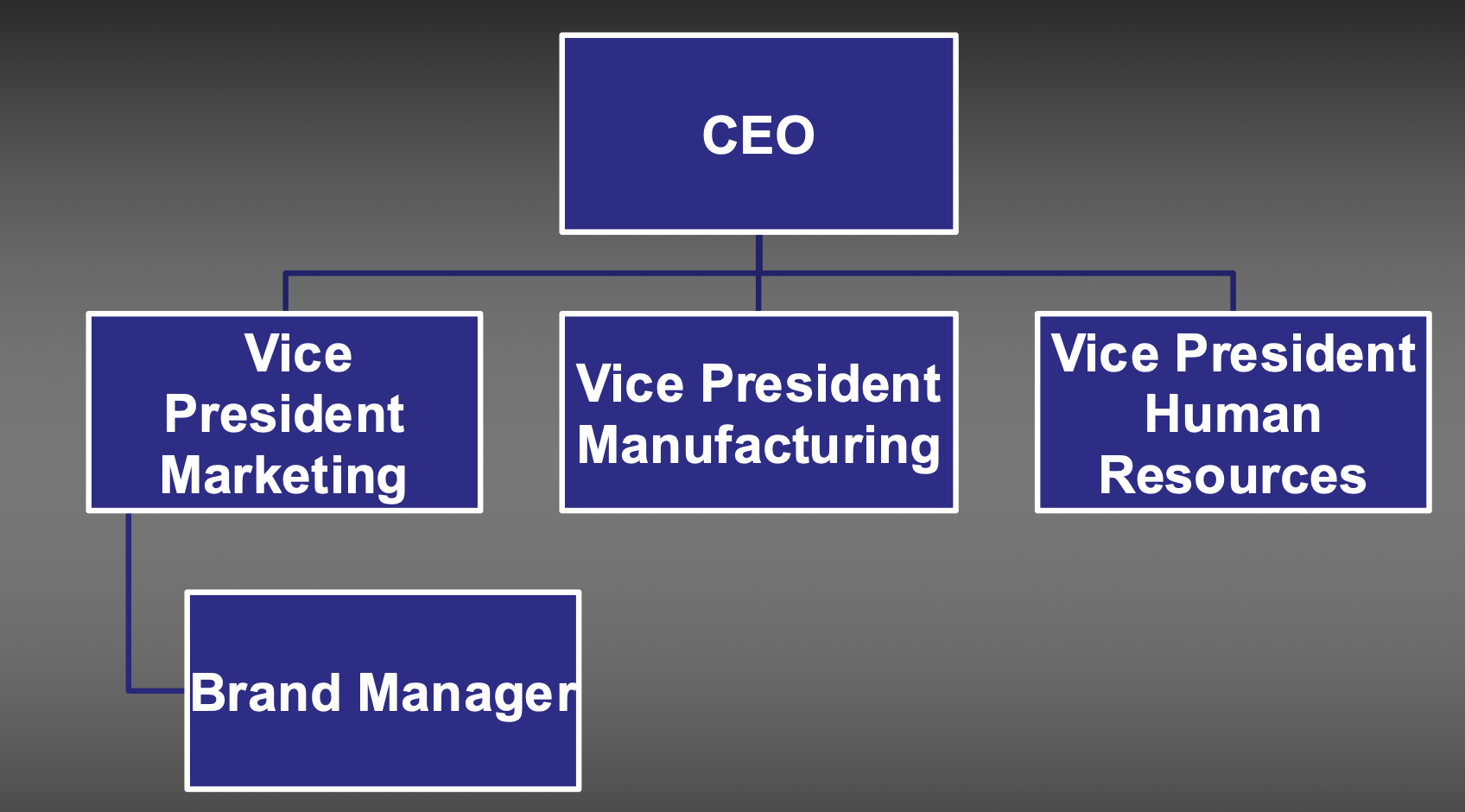
Span of Control
The number of employees reporting to a given supervisor.
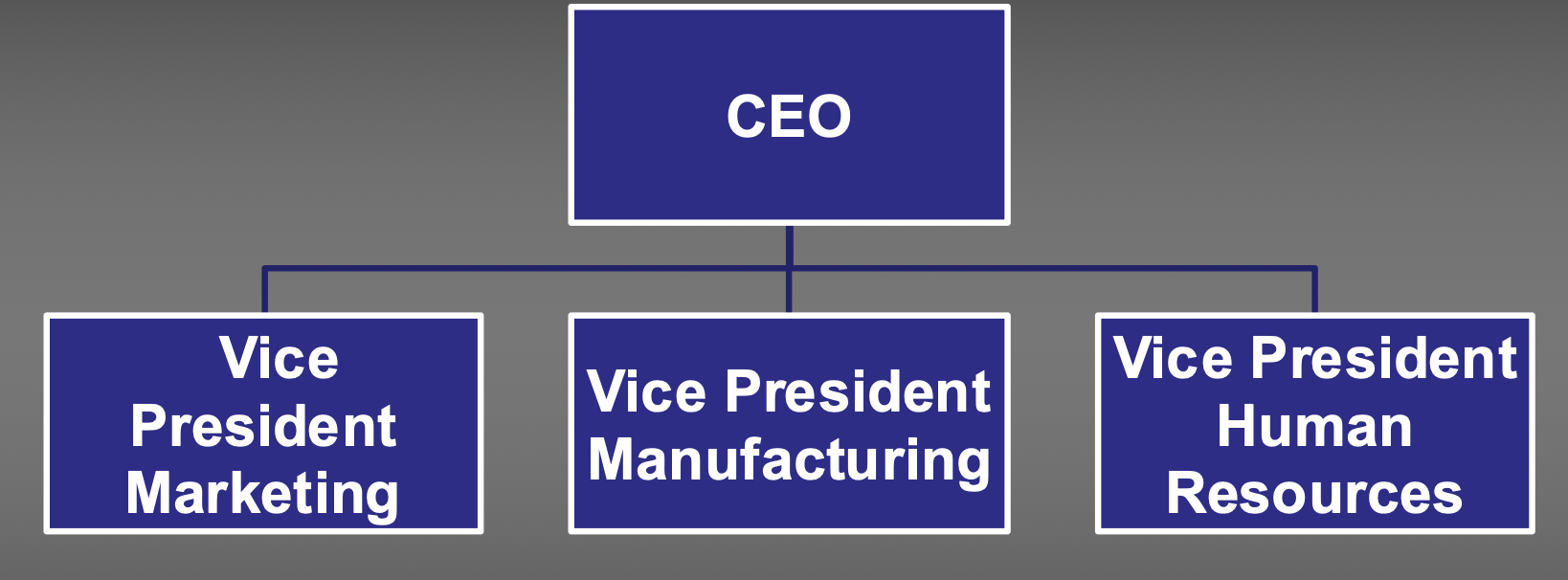
Spans of Control and Org Shape
Consistent patterns of span of control can affect the overall shape of an organization.
A narrow span of control throughout the organization results in a “tall” organizational structure (i.e., lots of layers).
A wide span of control results in a “flat” organizational structure (i.e., few layers).
Tall Organization Structures
Have multiple layers and are high in terms of vertical differentiation.
Tend to be slower at making decisions and responding to changes in the biz environment.
Best suited to stable external environments.
Example: American Airlines
Example of a Visual Rep. of an Tall Org. Structure

Flat Organizational Structures
Flat organizational structures have fewer layers than tall structures.
Tend to be quicker at making decisions and responding to changes.
Best suited to dynamic environments.
Example: Southwest Airlines
Example of a Visual Rep. of an Tall Org. Structure
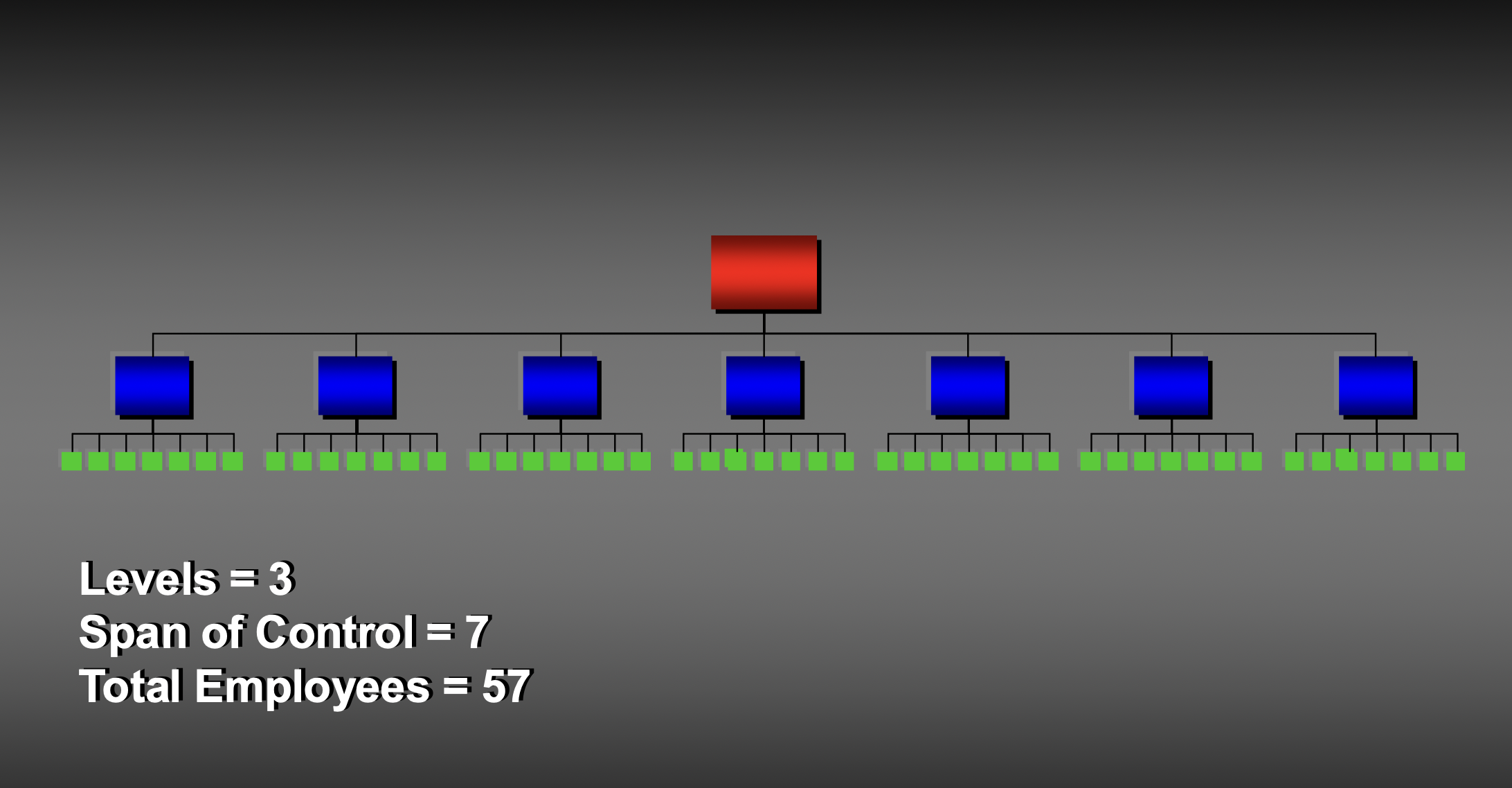
Factors that influence the Span of Control
Job Complexity
Job Similarity
Geographic Proximity of Supervised Employees
Amount of Coordination
Abilities of Employees
Degree of Employee Empowerment
Ability of Management
Technology
Spider (Tall) vs. Starfish (Flat) Type Of Org. Structures
Spider:
(traditional) organizations have a clear hierarchy, chain of command, and physical corporate headquarters.
Knowledge and power are concentrated at the top.
Remove the top leadership, and the organization can no longer function.
Starfish:
(non-traditional) organizations have no clear hierarchy or chain of command.
May have no physical corporate headquarters.
Knowledge and power are distributed throughout the organization.
Remove the top leadership, and the organization survives (regenerates).
Informalization
Unofficial but influential means of communication, decision making, and control that are part of the habitual way things get done in an organization.
These channels are not represented in organizational charts.
Informalization: The U.S vs. Japan
In Japan, decisions are often made in face-to-face meetings between people who do not have formal reporting relationships.
This process of informal communication and incremental decision-making is referred to as nemawasi.
Nemawasi
Informal decision-making process that takes place within Japanese companies between people who do not have official reporting relationships.
Formalization vs. Informalization
Formalization pertains to the reporting structure within the organization (i.e., whether there is a clear chain of command), whereas informalization are unofficial but influential means of communication, decision making, and control that are part of the habitual way things get done in an organization.
Centralization vs. Decentralization
Centralized organizations:
Restrict decision-making to fewer individuals, usually at the top of the organization.
Decentralized organizations:
Tend to push decision-making authority down to the lowest level possible.
Centralization: U.S. vs. Japanese Firms
Japanese firms exhibit a high degree of centralization.
Unlike in U.S. and European firms, decisions are not generally delegated.
Bamboo ceiling - tendency of Japanese firms to limit strategic decision-making in foreign subsidiaries to Japanese expatriate managers.
Combinations of Formal/Informal and Centralized/Decentralized (1)
US Military:
Decisions about strategy and tactics are made at the top of the organizational pyramid.
Coordination is achieved through rigidly structured, hierarchical relationships.
Decision-making structure: Type of Formalization:
CENTRALIZED FORMAL
Club Med:
General managers have considerable autonomy to make decisions about what
is best for their resorts.
Loose relationships exist between individual managers and those at the corporate HQ.
Decision-making structure: Type of Formalization:
DECENTRALIZED INFORMAL
Combinations of Formal/Informal and Centralized/Decentralized (2)
Mitsubishi:
Decisions about strategy and operations made at the top of the organizational pyramid by Japanese nationals.
Lots of communication between people who do not have formal reporting relationships.
Decision-making structure: Type of Formalization:
CENTRALIZED INFORMAL
Phillips Electronics:
Decisions about strategy and operations pushed down the organizational pyramid and made by local affiliates.
Coordination is achieved through rigid lines of authority and clear chains of
command.
Decision-making structure: Type of Formalization:
DECENTRALIZED FORMAL
Different Types of Common Organizational Structures (6)
Functional Structure
Product Structure
Division Structure
Customer Structure
Geographic/Regional Structure
Matrix Structure
Functional Structure
Used to organize the firm around traditional functional areas, such as accounting, finance, marketing, sales, manufacturing, etc.
Product Structure
Used to organize the firm around specific products or services; each is treated as a profit center.
Division Structure
Used to organize the firm around divisions, which typically consist of multiple products within a related area.
Customer Structure
Used to organize the firm around categories of customers.
Geographical/Regional Structure
Used to organize the firm around geographical areas or regions in which it has operations.
Matrix Structure
Consist of two organizational structures superimposed on each other, leading to dual reporting relationships.
Networked Structures
Formal or informal relationships among units or organizations (along the firm’s value chain)
low-networked:
Quantity and magnitude of externally networked activities is limited.
high-networked:
Larger quantity and magnitude of externally networked activities
Outsourcing
the practice of taking a significant activity within the organization and contracting that activity out to an independent party ← outside of the org.